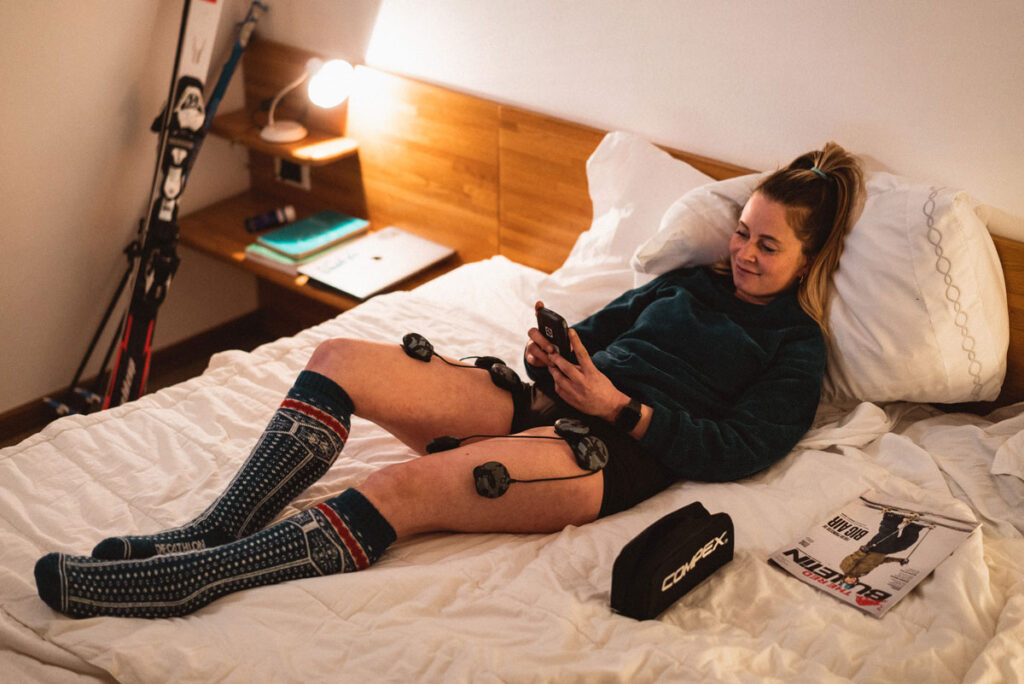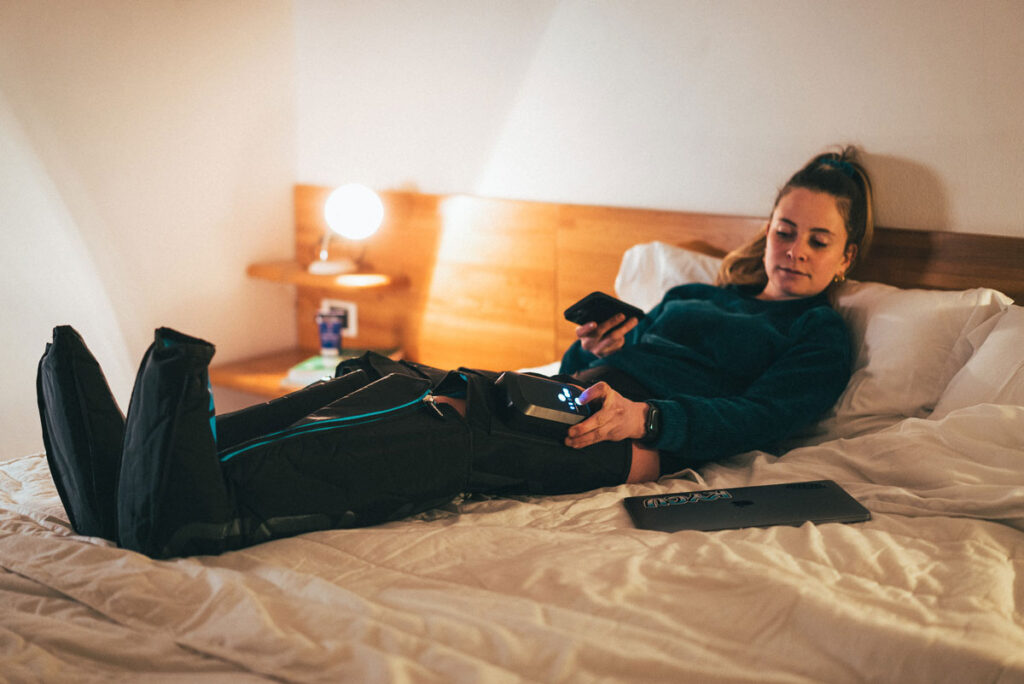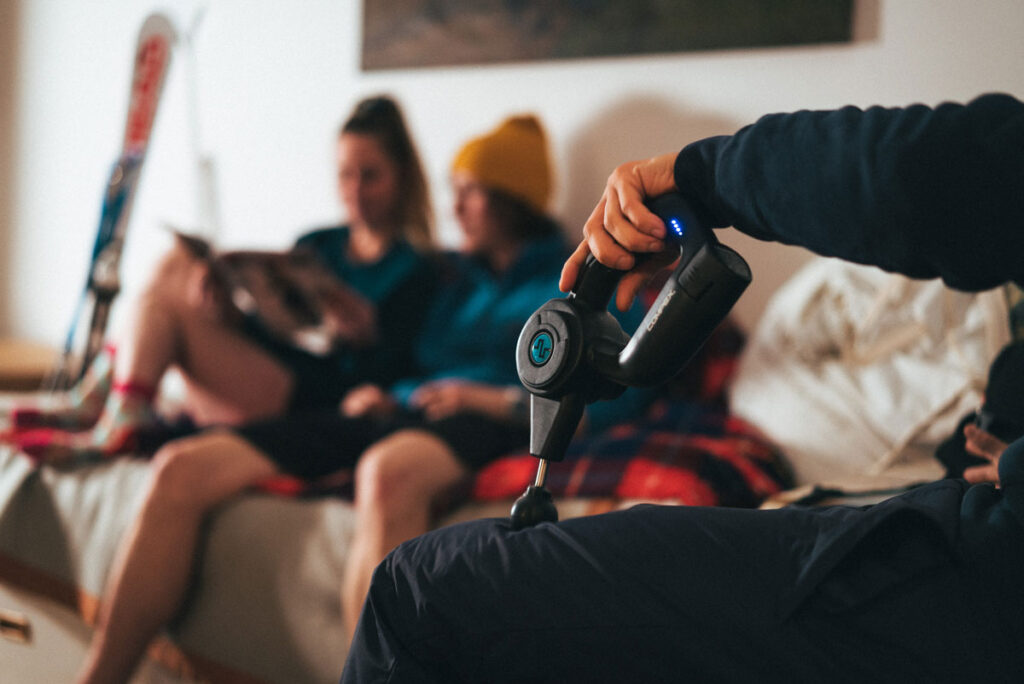Muscular Recovery After Skiing

All skiers recovery can benefit from good muscle recovery after skiing, whatever their level of ability and commitment. Often ignored, it is vital if you are to continue skiing safely and with comfort. Simple to put in place, it can be either active (low-intensity activity, stretching) or passive (using external aids). Before going into detail, we will define fatigue and understand why it is important to embrace recovery after skiing.
DEFINITION OF FATIGUE
According to Gandevia (2001), muscle fatigue corresponds to "the impairment of the ability to generate force or power following exercise, and whose cause may be central and/or peripheral". This definition shows us the complexity of fatigue, but the common consequence is "impairment".
Any training or sports load builds fatigue and leads to a short term drop in performance before a rebound effect to return to a state of superior fitness at the start. This is the overcompensation that is essential for progress. Now we will outline why this effort requires good recovery after skiing.
RECOVERY AFTER SKIING: WHY?
The aim of recovery after skiing is to limit and/or repair structural damage, reduce oxidative stress and excessive inflammation, accelerate the evacuation of the products of metabolic activity, and relieve muscle pain (Ispirlidis et al., 2008).
For the occasional skier, fatigue will be a factor in injury. Don't forget that the frequency of injuries varies according to the time of day, with 2 peaks: one at the beginning of the day due to a lack of warm-up or the quality of the snow (hard) and one at the end of the afternoon due to accumulated fatigue and the deterioration of the snow, as well as the significant differences between sunny and shaded areas.
HOW TO PRACTICE RECOVERY AFTER SKIING
Recovery after skiing is a prerequisite for good, safe skiing. Do this actively by finishing your days of downhill skiing or snowboarding on easier slopes and by slowing your speed. In cross-country skiing, the last ¼ of an hour should be spent on flat ground at low intensity. The contraction-relaxation movements of the muscles stimulate pumping, increase blood flow and the elimination of metabolites, and reduce intracellular volume.
The second way to do recovery after skiing is to use 'external' sources, devices that allow you to target a specific recovery mode.
Finally, whatever the process used, it is important to establish a diet suited to recovery. This involves not only the food you eat, but above all the drinks you drink. The right fluid balance is the basis of recovery. Increase your fluid intake at altitude or in extreme cold conditions.

RECOVERY AFTER SKIING: METHODS
Which muscles do you want to target for recovery after skiing? Do you have sore muscles or have you been working these muscles more intensely?
We advise you to use an electrostimulation device which offers the following benefits:
- Increased blood flow to supply nutrients and oxygen. This helps repair muscle fibers damaged during exercise, but also provides them with new nutrients.
- Promotes relaxation of muscle fibers, reducing discomfort due to the micro-injuries produced in our muscles during exercise.
- Improves well being by increasing the secretion of endorphins produced during the recovery program.
- Reduction or elimination of minor contractures that may have occurred during exercise and could be a limiting factor in future sessions.
- After an alpine skiing session, focus on the lower limbs (quadriceps, hamstrings, adductors, gluteus medius and gluteus maximus-TFL, lumbar).
Focus more on the muscles of the upper body, such as the trapezius, biceps and triceps, after a cross-country skiing session. These muscles are sometimes difficult to stretch but can be easily individualised with electrotherapy. This is one of the strong points of this technique.
Electrostimulation is just as effective as active recovery, but does not increase oxygen consumption in the lungs and superficial muscles.
DO YOU PREFER TO RECOVER THE LOWER LIMBS AS A WHOLE?
You'll need to use a pressotherapy device whose function will be to enable lymphatic drainage and thus eliminate the annoying water retention that causes fatigue and muscle pain, boosting recovery after skiing.
This, transferred to the world of physical activity, will enable you to eliminate the muscular waste products of exertion. The accumulation of these toxins causes muscle fatigue, so it's essential to be able to eliminate them as quickly as possible from our bodies. This expulsion from the body is carried out by the renal system, so it is very important to be well hydrated during the pressotherapy session.
More useful for endurance sports (cross-country skiing or hiking): you'll feel lighter and avoid night cramps. Although stretching should be done away from sport, you can start using the boots as soon as you stop exercising. You should lie with your legs slightly elevated, modulating the pressure according to how you feel.

CAN YOU IDENTIFY SPECIFIC POINTS OR AREAS FOR RECOVERY AFTER SKIING?
Use a massage gun for precision and effectiveness in 3 ways:
- Relaxing the muscle quickly,
- Eliminate tension points (trigger points - painful myofascials),
- Work the fascias (muscle group envelopes) to facilitate the sliding surfaces between them, enabling the supporting muscles to function better.
Staying active in your recovery after skiing also means getting to know your body better so you can better identify the areas that are suffering. The massage gun will target very precise areas (not just muscles) to avoid injury. These include the iliotibial (IT) band, which is used extensively in cross-country skiing, and which should be treated along its entire length in an up-down direction. Treat the fibular muscles also, as well as the front of the tibias to prevent periostitis in downhill skiing.
WANT TO SEE A PROFESSIONAL?
A physiotherapist will be best placed to apply certain techniques:
Massages: even if they have not been proven to be physiologically effective, they have the effect of improving feelings of fatigue by reducing pain.
Tape: these strips of adhesive fabric reduce pain by breaking down the neurological receptors under the skin. It will promote circulation and decompression of the blood and lymphatic channels. Placed by the physiotherapist on precise areas, with appropriate tension they have a continuous action over the long term.
CONCLUSION
Remember the most important points about skiers' recovery can be summed up in a few points:
- Reduce the risk of injury.
- Increase pleasure.
- Make faster progress.
You can achieve these actively and passively using specific equipment to target recovery.
BIBLIOGRAPHY
"Recovery and performance in sport" Christophe Hausswirth - Ed. INSEP
"Recovering injured athletes" Eric and Michelle VIEL - Ed. Masson
"Improving recovery in sport" Christophe Hausswirth - Ed. INSEP
"Neuromuscular electrostimulation and short-term recovery: implications for the performance of elite athletes" Rachel Borne - 2016
"Evidence of the physiotherapeutic interventions currently used after exercise-induced muscle damage: systematic review and meta-analysis" Torres and Al. - Physiotherapists in Sports Medicine - 2012
"Delayed onset muscle soreness: is massage effective?" Nelson - Journal of Bodywork and Movement Therapies - 2013
Do not ignore pain. If it is pronounced and/or lasts too long, it is advisable to consult a doctor.
PROVEN EFFECTIVENESS
Backed by clinical studies proving their effectiveness, Compex stimulators are class II medical devices and meet the needs of European Medical Standard 93/42 EEC.
Compex - Always with you
We're on the side of athletes, amateurs and also ordinary people. From the search for better performance to post injury recovery, from post fatigue massage to pain treatment. At Compex, we have just one goal: people's well being.
To choose the one that's right for you, take a look at our buying guide.
Read our experts' advice on the official blog, catch the latest Compex news by subscribing to our newsletter. You can also watch our videos on the YouTube channel and follow us on Facebook and Instagram to stay up-to-date.









